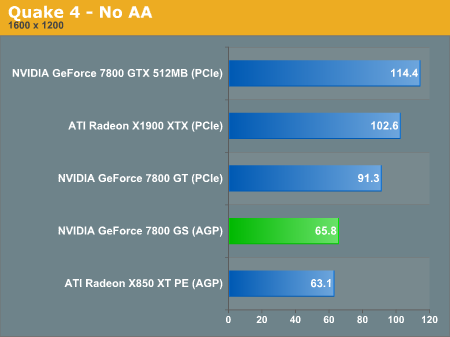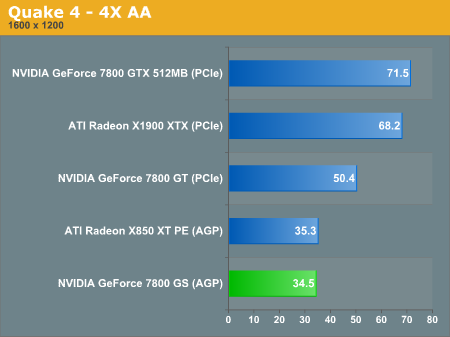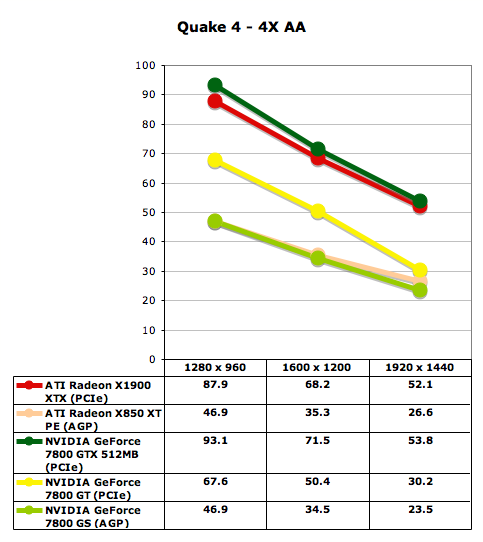Quake 4 Performance
The X850 XT PE and the 7800 GS perform all but the same under Quake 4. This implys that other Doom 3 powered games will also exhibit the same characteristics. Both these cards are playable at 1920x1440 without AA and 1600x1200 with 4xAA enabled. This results in quite an enjoyable Quake 4 experience.
The X850 XT PE and the 7800 GS perform all but the same under Quake 4. This implys that other Doom 3 powered games will also exhibit the same characteristics. Both these cards are playable at 1920x1440 without AA and 1600x1200 with 4xAA enabled. This results in quite an enjoyable Quake 4 experience.














93 Comments
View All Comments
sandman74 - Friday, February 3, 2006 - link
Agreed.
How about it Derek, any chance that this review can be updated or are we going to have to wait a while until your next AGP face-off that you alluded to in the review ?
Thanks,
sm74
JamesDax - Friday, February 3, 2006 - link
I too am looking forward to an update to this review. I do have one question though. Isn't the X850XT PE just a factory oc'd X850XT? I mean besides the clock speeds there really isn't any difference between the two. So that being the case didn't he in fact underclock those two 7800GS's and bench them against a oc'd X850XT??coldpower27 - Friday, February 3, 2006 - link
There is a difference, the X850 XT PE is an official SKU from ATI, even though it's only a bit faster then the X850 XT.This is the same situation that is occuring with the X1900 XT and X1900 XTX now.
Derek underclocked the 7800 GS to the point of Nvidia's minimum specs for this SKU 375/1200, but this doesn't represent the performance of the product we will be getting from certain manufacturers, such as the eVGA Superclock edition.
JamesDax - Friday, February 3, 2006 - link
That's a pretty weak argument. The fact is he under clocked those cards below there off the shelf speeds and tested them against what is essentially an overclocked X850XT. He could have redeemed himself if he had just included the benches for the 7800GS's at their factory oc'd stock speeds. As it is, he misrepresented the performance of those cards.coldpower27 - Saturday, February 4, 2006 - link
You misunderstand me.I am not arguing that this review is good, quite the contrary is what I believe as it stands now.
The 7800 GS should have been compared at Nvidia's reference design speeds and using eVGA's 7800 GS SuperClock Edition speeds as well as that represents the product the consumer will get.
Using Nvidia's reference designs speeds only represents the worse case scenario which isn't good enough.
unclebud - Friday, February 3, 2006 - link
just a quick thanks for reviewing an agp card solution -- rather thoroughly imo, i might add... peace.Spacecomber - Friday, February 3, 2006 - link
This card will spark alot of interest for people like myself who want to get as much life out of their AGP system as is practical before deciding that it's time to do a more complete system upgrade.In my case, I'm still running an Athlon XP at 2.3GHz, and since upgrading from a Ti4600 to a 6800GT, when Battlefield 2 came out, I have a viable, mid-range game system (it plays Battlefield 2 at 1024x768 with mostly high settings). This has allowed me to postpone that upgrade to a new PCI-E based system, for now.
So, the question is for me whether any new AGP card will provide yet another intermediate upgrade step before the inevitable upgrade to a PCI-E system. This means that I do want to know how the peformance from this new AGP card stacks up against the kind of PCI-E cards that I would likely to looking at (such as the 7800GT, probably the best bang for your buck PCI-E card, and the X1900XT, an example of what the top end cards have to offer). I also want to know how much faster this new AGP card is compared to the other top end AGP cards, such as the X850XT PE that you tested, as well as other cards that people are likely to be using now, such as the 6800GT/GS, X800XL, 6800 Ultra, etc. Not all of these cards need to be included, of course, but enough to give a feel for how the new card stacks up against the old guard.
Finally, but not least, I want to know about what sort of value this new card has to offer. How much is it selling for? Does this card seem to have alot of overclocking headroom, and if so, when running it at an overclocked speed, what cards is it comparable to?
Assuming that this new AGP card has enough horsepower to make it a significant upgrade from what someone is already running in their legacy system, how does the cost of this single component upgrade compare to the cost of a more complete overhaul to a PCI-E system of at least comparable speed (i.e., PCI-E motherboard, processor, and video card)?
Those are the sort of questions that I will be looking for answers to when I investigate what a card like the 7800GS AGP has to offer.
Space
bobbyto34 - Friday, February 3, 2006 - link
Nice review...It's not complete because we don't have comparisons with other AGP cards (6800/6800GT), but we can deduce it ourselves :) Maybe later AT will add these tests !
I want to keep my A64 3400+ but change my 6800GT to a more powerfull card without eating bread for 3 months... I was considering buying a 7800GT + nforce 4 socket 754 board or a 7800GS AGP.
I think I'll wait a few months to see what happens : the 7800GT + mobo costs nearly the same price than a 7800GS here in France, for more performance... But the 7800GT is already struggling in 1280 with recent games (ie Fear).
Wait and see...
Sorry for my English, i'm from france :p
BenSkywalker - Friday, February 3, 2006 - link
You underclock the boards from what is actually available....You leave out MOST of its direct competitors.....
You rig 20% of your tests to make the board lose to the only direct competitor you bothered to test.....
What is happening? If a part has issues then let them come out on their own- too high a price and not enough performance- OK, but let it come through on an honest basis. This review is something considerably below you ignoring it all together.
PrinceGaz - Thursday, February 2, 2006 - link
The 6800GT was for a long time the AGP card of choice, and the 6800GS has replaced it recently as it is cheaper and only slightly slower. Given how either of those two cards would have been what AGP users might have considered, or still be considering, the lack of a 6800GS in your benchmarks was unforgivable. For what it's worth I'll say a stock 7800GS is slightly faster than a stock 6800Ultra, and therefore has a decent margin over a 6800GT, and especially a 6800GS. The real strength of the 7800GS is in its overclocking headroom though, as you pointed out. That doesn't necessarily make it a good purchase though.Anyone who wants to hang on to an AGP based system could use a 7800GS to upgrade from the likes of a 6600GT or lower, but I really think their money would be better spent on moving to a PCIe platform and graphics-card.